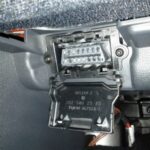So, you’ve just joined the ranks of E36 BMW owners? Congratulations! It’s understandable you’re diving into diagnostics right away, especially with a handy OBD2 Bluetooth scanner. Let’s clear up some common questions for those navigating the OBD2 system on their E36, particularly the 1996 models which are often a point of transition.
OBD2 Port vs. 20-Pin BMW Connector: What’s the Difference?
You’re right to notice both ports. The OBD2 port is the standard, legally mandated port you’ll find in most cars from 1996 onwards. The 20-pin BMW diagnostic connector is a holdover from pre-OBD2 BMWs.
Think of the OBD2 port as a more universal, but potentially limited, window into your car’s computer. The 20-pin connector, on the other hand, often provides deeper access to various BMW-specific systems. While your OBD2 Bluetooth scanner will plug directly into the OBD2 port, it might not access everything. No wire jumping needed for OBD2 – it’s plug-and-play. For the 20-pin, you would need a specific adapter to convert it to OBD2 if you wanted to use your Bluetooth scanner with it, though that’s not typically done.
Limited Metrics with OBD2 Bluetooth: Is it Normal?
Seeing only coolant temperature and RPM is a common frustration with basic OBD2 scanners on older OBD2 BMWs like the E36. While OBD2 is a standard, the amount of data accessible via the standard OBD2 protocols can be limited, especially for systems beyond basic emissions monitoring. Your scanner isn’t necessarily faulty; it’s likely just reading the standardized OBD2 data, which, on an E36, might not include everything you want to see like O2 sensor or MAF readings in detail.
For more in-depth diagnostics on your E36, especially pulling data beyond basic OBD2 parameters, you’ll likely need software that can communicate with BMW-specific protocols.
Diving Deeper: INPA and DIS Diagnostic Software
You’ve stumbled upon the right tools! INPA and DIS (Diagnostic Information System) are indeed powerful BMW-specific diagnostic software. INPA is generally considered more for coding and quick tests, while DIS is a more comprehensive diagnostic suite.
To interface with your E36 using INPA or DIS for advanced diagnostics, direct OBD2 connection might be limiting, especially for older models. While some newer interfaces can work through OBD2 for certain functions, for full access, particularly with DIS, you’ll likely need a specialized interface and often the 20-pin connector. Traditionally, DIS was designed to work with a different interface altogether (like the BMW GT1 interface). INPA can work with simpler interfaces, but often benefits from a 20-pin connection for older BMWs to access all modules.
For learning to use INPA and DIS, online forums and BMW-specific communities are your best resources. There are numerous guides and tutorials available that can walk you through installation and basic usage. Keep in mind that these are more advanced tools, and it’s crucial to proceed cautiously and research thoroughly before making changes to your car’s systems.
Hopefully, this clarifies the OBD2 Bluetooth situation with your E36 and points you in the right direction for deeper diagnostics! Happy wrenching!
